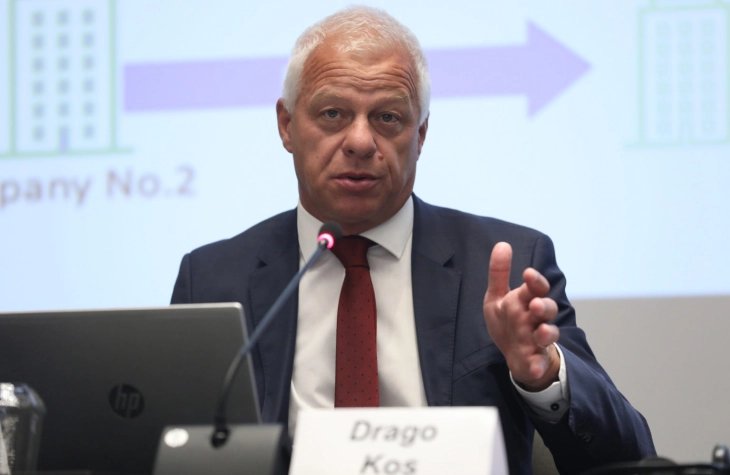Kos: Illegal banking scheme has been operating in North Macedonia since 2004

Skopje, 22 August 2022 (MIA) – Since 2004, there has been a well-established scheme in the Republic of North Macedonia through which several commercial banks have systematically violated the applicable regulations in banking, in order to be able to carry out illegal lending in addition to legal lending, mostly to entities unable to access bank loans, show part of the conclusions of the team of banking crime experts led by European expert Drago Kos, after an independent investigation was conducted into the bankruptcy of Eurostandard Bank.
According to the experts, the scheme worked in such a way that a certain bank has identified companies willing to give up their business accounts, to whom the bank then paid certain amounts based on fictitious lending agreements, and then the companies formally loaned those amounts to other companies, exclusively by choice and as organized by the bank.
In a similar way, these funds were then returned to the bank. In that way, the bank has realized profit from artificially increased credit placements, paid commissions, interest rates, penalty interest and other costs, while the companies that acted as transmitters of illegally acquired money, i.e. converting credits into loans, usually suffered major loss due to the exceptional scale of the scheme which didn’t allow the possibility of exercising control.
“None of the companies involved in this scheme were fully aware of this, as it involved many banks and companies whose representatives, despite large cash transactions, often didn’t even know each other. None of these companies could keep records of all payments, because they simply didn’t know about them, particularly if the money was transferred through other companies and through commercial banks other than theirs. Only the banks, at least in the initial stages, could monitor the flow of this lending and loaning process, and as the scheme developed, even they began to lose control over who paid whom and who owed whom,” reads the report.
Given the fact that such swift funding could not be secured otherwise, relevant legal documents were signed extremely quickly or prepared later, while transfer orders were executed outside business hours. Due to the dynamics of events, all persons whose signature was needed weren’t always available, which is why it was necessary for their signatures to be forged on transfer orders, credit agreements, loan agreements, etc., and this happened in the largest number of cases. Often, the people whose signatures were forged were not even aware of it.
In the full report, which stretches over hundreds of pages and will be available at www.covekotpredse.mk, an analysis has been made in connection with one of these cases, in which the illegal lending scheme managed by Komercijalna banka AD Skopje is described, in most cases through the business accounts of two companies.
“In the period between 2004 and 2011, seven banks, 45 other companies and one natural person were involved in the scheme. In the same period, at least 103 forged signatures on transfer orders, five forged signatures on credit agreements and 32 forged signatures on loan agreements were proven, and 40 fictitious credit agreements and 81 fictitious loan agreements have been prepared and signed. In addition, for approximately 54 transactions between companies that were involved in the scheme, no loan agreements were concluded at all, which points to the fact that Komercijalna Banka, due to the scale of the scheme and the number of banks and companies involved in it, finally lost all control over it. Through this scheme, which operated from 2004 to 2011, only through two companies, Komercijalna Banka earned EUR 5,573,602 in illegally acquired profits, while these two companies suffered damages in the amount of EUR 21,601,991,” reads the report.
The largest shareholder in Eurostandard Bank, businessman Trifun Kostovski, pointed out that the role of Komercijalna Banka has been particularly investigated by Drago Kos.
“With my statement, I only want to reveal that EUR 3 million, a specially given deposit from Eurostandard Bank, which cannot be repurposed or used for other needs, were illegally used, without the consent of the supervisory boards of the two banks. In an agreement, known only to the management boards of the two banks, these funds have disappeared,” Kostovski said.
According to Kostovski, Eurostandard Bank has been driven into bankruptcy with intent. Without his and the shareholders' knowledge, Eurostandard Bank has been involved in the illegal schemes, and the National Bank hadn’t used all the tools at its disposal.
The National Bank, he added, only used regular measures and bankruptcy as tools, whereas extraordinary measures were partially used, although it was within its competence to revoke the licenses of the members of the Management and Supervisory Boards and directors of departments. The administration tool has also been skipped.
One of the findings in the report is that the National Bank has refused to recognize and prevent the existence of the scheme during the period from 2004 until now, despite having knowledge of all its components. When Eurostandard Bank faced major issues, the central bank has formally cited inadequate management of the loan portfolio and related risks as the cause of the bank's poor condition, but had not proceed to dealing with the illegal scheme.
The National Bank has only acted on one consequence of the inadequate management of the credit portfolio and related risks: the decline of the capital adequacy ratio. Given the fact that the central bank has deliberately failed to recognize the real roots of the problem in the Eurostandard Bank and has not applied all the necessary corrective measures to eliminate those roots, its intensive efforts to save Eurostandard Bank were in vain, the report reads among other.
Given the fact that no bankruptcy proceedings were initiated in August 2019, the report adds, there are serious doubts as to whether the moment of initiating bankruptcy proceedings on August 12, 2020 was appropriately chosen.







